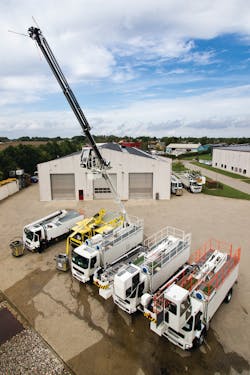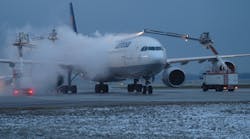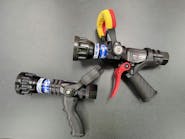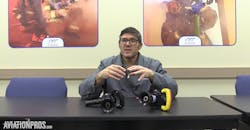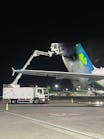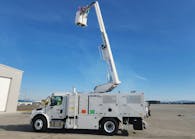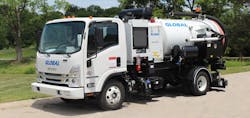It’s about 4,200 miles from McHenry, IL to Vestergaard Company A/S headquarters in Gevninge, Denmark, and June isn’t anywhere close to deicing weather in either place.
But if you wanted to see one of the company’s Elephant deicer trucks go through its paces as it was prepped for delivery, all you needed to do was drive into the parking lot of the company’s North American office.
“I was a customer before I started working for Vestergaard,” says Brock Crocker, business manager for Vestergaard Company Inc., its North American subsidiary.
While the company opened the McHenry office in 1996, Vestergaard actually started selling its deicers in 1989. One of its first North American sales was to Crocker’s old employer, United Airlines.
Crocker managed the airline’s very busy deicing operations at O’Hare International Airport. When United first considered purchasing the vehicles, Crocker helped the purchasing executives see the long-term value of the higher-priced vehicles.
“Return on investment has to be proven for vehicles like ours that carry a larger price tag” Crocker says.
To prove that ROI, Crocker pointed out the obvious to us in the parking lot. The Elephant trucks aren’t called “Elephants” for nothing. A telescoping boom with a reach of more than 30 feet is what delivers the fluid.
“The boom gets the fluid right next to the skin of the airplane,” he says. That minimum distance does two things. Operators use less fluid to deice aircraft. But more importantly, the heated fluid travels less of a distance in the air and retains more heat compared to its competitors' models.
“It’s the heat of the fluid that breaks the bond of the ice with the aircraft,” Crocker says. “That was a key decision back then with United – to not only use less glycol, but deice aircraft more effectively.”
One more benefit of the truck is the maneuverability of the boom.
“An operator can deice one side of the plane without repositioning the vehicle,” Crocker says. “And that maintains a safe distance between truck and aircraft.”
Right now, the boom extends to a maximum length of 10 meters (33 feet). But vehicles coming off the assembly line in Denmark have a boom that can reach 12 meters (39 feet). Company literature says the added length can keep the nozzle within 1 meter (3 feet) of the surface of virtually any aircraft.
Crocker says Vestergaard has around 260 deicer trucks at airports in North America. Apart from sales efforts, the North American subsidiary employs eight people and maintains a parts and service operation for the United States and Canada from the McHenry site.
While our focus was on deicing, the company also makes water service trucks and vacuum toilet service trucks, and recently sold almost 50 VSUs to a U.S. carrier – one of the largest one-time sales for the product line.
For deicers, however, Crocker says the latest proposals from the EPA on deicing fluid should play to the favor of his equipment.
“I think those proposals are all about paying attention to the amount of glycol used in deicing,” he explains. “If airports can turn that amount down at the source, that a good thing.”
50 YEARS OLD
Vestergaard Company A/S recently marked its first 50 years in business.
“We’ve made more than 1,000 deicers in the past 50 years, and the company has expanded considerably in just the past few years,” says Helle B. Vestergaard, the company’s marketing and communications manager.
Vestergaard currently employs around 250 people worldwide with much of the work centered at its production facilities in Gevninge. Vestergaard also operates offices in Japan, Russia for the CIS market and Italy. This year, the company plans to expand with subsidiaries in France and Thailand. The Thailand operation will also manufacturer GSE especially for the Asian market.
In addition to equipment, the company also offers customers a data transmission service, which records important deicing data throughout the season and easily stores the documentation on a Vestergaard server. The Vestergaard Academy provides “tailored” training to its customer’s operators and service personnel (as well as its own employees). Courses are either held at a customer’s facility or in classrooms at Vestergaard headquarters.
Here are a few highlights of the past 50 years:
- 1962: Godtfred Vestergaard starts “Ingeniørfirmaet G. Vestergaard” at his home outside Copenhagen. The company’s original product was aluminum molds for constructing mattresses. Later, the company started making lifts for a university near Copenhagen. Also, the company manufactured a piano lifting device for a music academy, a stage platform for a theater and attractions at the Tivoli Garden.
- 1966: SAS asks Vestergaard to modify existing deicers. As a result, the company received an order to make new deicers. Nicknamed “Beanstalks,” the units consisted of a vertical, telescopic tower with a platform on top. An operator applied fluid to the aircraft using a spray gun. But SAS was soon buying larger American deicers with the advent of wide-body aircraft. The American units, however, suffered from several serious deficiencies, and once more Vestergaard was asked to make a number of modifications on the units.
- 1981: Vestergaard starts building a new type of deicer, the Elephant Alfa, equipped with the now familiar telescopic spray boom. The Elephant MY and Elephant Beta and the Elephant BETA-15 will follow.
- 1996: Godtfred Vestergaard retires as CEO. His son Stefan takes over.
- 1997: Vestergaard Company Inc. (North American operations) established.
- 2002: Ingeniørfirmaet G. Vestergaard celebrates 40th anniversary and changes name to Vestergaard Company A/S.
- 2009: First Elephant SIGMA introduced.
- 2012: Vestergaard Company Asia established and Elephant Beta NG introduced.
